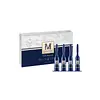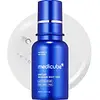What's inside
What's inside
 Key Ingredients
Key Ingredients

 Benefits
Benefits

 Concerns
Concerns

 Ingredients Side-by-side
Ingredients Side-by-side

Water
Skin ConditioningButylene Glycol
HumectantPropylene Glycol Dicaprylate/Dicaprate
EmollientHydrolyzed Sponge
Skin ConditioningCetyl Ethylhexanoate
EmollientGlycerin
Humectant1,2-Hexanediol
Skin ConditioningCetearyl Alcohol
EmollientMacadamia Ternifolia Seed Oil
EmollientButyrospermum Parkii Butter
Skin ConditioningDimethicone
EmollientPolyglutamic Acid
Skin ConditioningSorbitan Stearate
EmulsifyingPolysorbate 60
EmulsifyingGlyceryl Stearate
EmollientPEG-100 Stearate
Cyclopentasiloxane
EmollientPanthenol
Skin ConditioningSimmondsia Chinensis Seed Oil
EmollientAsparagus Officinalis Extract
Skin ConditioningHydrogenated Starch Hydrolysate
HumectantCyclohexasiloxane
EmollientGlycosyl Trehalose
Emulsion StabilisingParfum
MaskingArginine
MaskingAcrylates/C10-30 Alkyl Acrylate Crosspolymer
Emulsion StabilisingNelumbo Nucifera Callus Culture Extract
AntimicrobialBeta-Glucan
Skin ConditioningPortulaca Oleracea Extract
Skin ConditioningPaeonia Suffruticosa Root Extract
Skin ProtectingEthylhexylglycerin
Skin ConditioningTocopheryl Acetate
AntioxidantChondrus Crispus Powder
AbrasiveAllantoin
Skin ConditioningAgar
MaskingCI 77891
Cosmetic ColorantSynthetic Fluorphlogopite
CI 77491
Cosmetic ColorantMica
Cosmetic ColorantAmmonium Acryloyldimethyltaurate/Vp Copolymer
Scutellaria Baicalensis Root Extract
AstringentCoptis Japonica Root Extract
Skin ConditioningPhellodendron Amurense Bark Extract
Skin ConditioningRheum Palmatum Root Extract
AstringentBletilla Striata Root Extract
Skin ConditioningSodium Hyaluronate
HumectantXanthan Gum
EmulsifyingDisodium EDTA
Glycine
BufferingSerine
MaskingGlutamic Acid
HumectantAspartic Acid
MaskingLeucine
Skin ConditioningAlgin
MaskingPectin
Emulsion StabilisingGellan Gum
Alanine
MaskingLysine
Skin ConditioningTyrosine
MaskingPhenylalanine
MaskingThreonine
Proline
Skin ConditioningValine
MaskingIsoleucine
Skin ConditioningCeramide NP
Skin ConditioningCitric Acid
BufferingHistidine
HumectantMethionine
Skin ConditioningCysteine
AntioxidantAlanine/Histidine/Lysine Polypeptide Copper Hcl
Skin ConditioningAcetyl Hexapeptide-8
HumectantPalmitoyl Pentapeptide-4
Skin ConditioningSh-Oligopeptide-1
Skin ConditioningSh-Polypeptide-1
Skin ConditioningWater, Butylene Glycol, Propylene Glycol Dicaprylate/Dicaprate, Hydrolyzed Sponge, Cetyl Ethylhexanoate, Glycerin, 1,2-Hexanediol, Cetearyl Alcohol, Macadamia Ternifolia Seed Oil, Butyrospermum Parkii Butter, Dimethicone, Polyglutamic Acid, Sorbitan Stearate, Polysorbate 60, Glyceryl Stearate, PEG-100 Stearate, Cyclopentasiloxane, Panthenol, Simmondsia Chinensis Seed Oil, Asparagus Officinalis Extract, Hydrogenated Starch Hydrolysate, Cyclohexasiloxane, Glycosyl Trehalose, Parfum, Arginine, Acrylates/C10-30 Alkyl Acrylate Crosspolymer, Nelumbo Nucifera Callus Culture Extract, Beta-Glucan, Portulaca Oleracea Extract, Paeonia Suffruticosa Root Extract, Ethylhexylglycerin, Tocopheryl Acetate, Chondrus Crispus Powder, Allantoin, Agar, CI 77891, Synthetic Fluorphlogopite, CI 77491, Mica, Ammonium Acryloyldimethyltaurate/Vp Copolymer, Scutellaria Baicalensis Root Extract, Coptis Japonica Root Extract, Phellodendron Amurense Bark Extract, Rheum Palmatum Root Extract, Bletilla Striata Root Extract, Sodium Hyaluronate, Xanthan Gum, Disodium EDTA, Glycine, Serine, Glutamic Acid, Aspartic Acid, Leucine, Algin, Pectin, Gellan Gum, Alanine, Lysine, Tyrosine, Phenylalanine, Threonine, Proline, Valine, Isoleucine, Ceramide NP, Citric Acid, Histidine, Methionine, Cysteine, Alanine/Histidine/Lysine Polypeptide Copper Hcl, Acetyl Hexapeptide-8, Palmitoyl Pentapeptide-4, Sh-Oligopeptide-1, Sh-Polypeptide-1
Water
Skin ConditioningDipropylene Glycol
HumectantGlycerin
HumectantButylene Glycol
Humectant1,2-Hexanediol
Skin ConditioningNiacinamide
SmoothingSodium Polyacrylate
AbsorbentEthylhexyl Palmitate
EmollientHydrolyzed Sponge
Skin ConditioningC12-14 Alketh-12
EmulsifyingHydrogenated Polydecene
EmollientEthylhexylglycerin
Skin ConditioningAdenosine
Skin ConditioningCaprylyl/Capryl Glucoside
CleansingDisodium EDTA
Panthenol
Skin ConditioningCalcium Silicate
AbsorbentLactobacillus Extracellular Vesicles
Campsis Grandiflora Flower Extract
AntioxidantPueraria Lobata Root Extract
HumectantPinus Palustris Leaf Extract
TonicOenothera Biennis Flower Extract
AstringentUlmus Davidiana Root Extract
Skin ConditioningSodium Silicate
BufferingBetaine Salicylate
AntimicrobialCitric Acid
BufferingGluconolactone
Skin ConditioningWater, Dipropylene Glycol, Glycerin, Butylene Glycol, 1,2-Hexanediol, Niacinamide, Sodium Polyacrylate, Ethylhexyl Palmitate, Hydrolyzed Sponge, C12-14 Alketh-12, Hydrogenated Polydecene, Ethylhexylglycerin, Adenosine, Caprylyl/Capryl Glucoside, Disodium EDTA, Panthenol, Calcium Silicate, Lactobacillus Extracellular Vesicles, Campsis Grandiflora Flower Extract, Pueraria Lobata Root Extract, Pinus Palustris Leaf Extract, Oenothera Biennis Flower Extract, Ulmus Davidiana Root Extract, Sodium Silicate, Betaine Salicylate, Citric Acid, Gluconolactone
 Reviews
Reviews

Ingredients Explained
These ingredients are found in both products.
Ingredients higher up in an ingredient list are typically present in a larger amount.
1,2-Hexanediol is a synthetic liquid and another multi-functional powerhouse.
It is a:
- Humectant, drawing moisture into the skin
- Emollient, helping to soften skin
- Solvent, dispersing and stabilizing formulas
- Preservative booster, enhancing the antimicrobial activity of other preservatives
Butylene Glycol (or BG) is used within cosmetic products for a few different reasons:
Overall, Butylene Glycol is a safe and well-rounded ingredient that works well with other ingredients.
Though this ingredient works well with most skin types, some people with sensitive skin may experience a reaction such as allergic rashes, closed comedones, or itchiness.
Learn more about Butylene GlycolCitric Acid is an alpha hydroxy acid (AHA) naturally found in citrus fruits like oranges, lemons, and limes.
Like other AHAs, citric acid can exfoliate skin by breaking down the bonds that hold dead skin cells together. This helps reveal smoother and brighter skin underneath.
However, this exfoliating effect only happens at high concentrations (20%) which can be hard to find in cosmetic products.
Due to this, citric acid is usually included in small amounts as a pH adjuster. This helps keep products slightly more acidic and compatible with skin's natural pH.
In skincare formulas, citric acid can:
While it can provide some skin benefits, research shows lactic acid and glycolic acid are generally more effective and less irritating exfoliants.
Most citric acid used in skincare today is made by fermenting sugars (usually from molasses). This synthetic version is identical to the natural citrus form but easier to stabilize and use in formulations.
Read more about some other popular AHA's here:
Learn more about Citric AcidDisodium EDTA plays a role in making products more stable by aiding other preservatives.
It is a chelating agent, meaning it neutralizes metal ions that may be found in a product.
Disodium EDTA is a salt of edetic acid and is found to be safe in cosmetic ingredients.
Learn more about Disodium EDTAEthylhexylglycerin (we can't pronounce this either) is commonly used as a preservative and skin softener. It is derived from glyceryl.
You might see Ethylhexylglycerin often paired with other preservatives such as phenoxyethanol. Ethylhexylglycerin has been found to increase the effectiveness of these other preservatives.
Glycerin is already naturally found in your skin. It helps moisturize and protect your skin.
A study from 2016 found glycerin to be more effective as a humectant than AHAs and hyaluronic acid.
As a humectant, it helps the skin stay hydrated by pulling moisture to your skin. The low molecular weight of glycerin allows it to pull moisture into the deeper layers of your skin.
Hydrated skin improves your skin barrier; Your skin barrier helps protect against irritants and bacteria.
Glycerin has also been found to have antimicrobial and antiviral properties. Due to these properties, glycerin is often used in wound and burn treatments.
In cosmetics, glycerin is usually derived from plants such as soybean or palm. However, it can also be sourced from animals, such as tallow or animal fat.
This ingredient is organic, colorless, odorless, and non-toxic.
Glycerin is the name for this ingredient in American English. British English uses Glycerol/Glycerine.
Learn more about GlycerinHydrolyzed sponge comes from marine or freshwater sponges. This is the main ingredient for "spicules".
In some products, tiny microneedles called spicules are made from silica or hydrolyzed sponge. They help push active ingredients into the skin to enhance the penetration and efficacy of these ingredients.
Panthenol is a common ingredient that helps hydrate and soothe the skin. It is found naturally in our skin and hair.
There are two forms of panthenol: D and L.
D-panthenol is also known as dexpanthenol. Most cosmetics use dexpanthenol or a mixture of D and L-panthenol.
Panthenol is famous due to its ability to go deeper into the skin's layers. Using this ingredient has numerous pros (and no cons):
Like hyaluronic acid, panthenol is a humectant. Humectants are able to bind and hold large amounts of water to keep skin hydrated.
This ingredient works well for wound healing. It works by increasing tissue in the wound and helps close open wounds.
Once oxidized, panthenol converts to pantothenic acid. Panthothenic acid is found in all living cells.
This ingredient is also referred to as pro-vitamin B5.
Learn more about PanthenolWater. It's the most common cosmetic ingredient of all. You'll usually see it at the top of ingredient lists, meaning that it makes up the largest part of the product.
So why is it so popular? Water most often acts as a solvent - this means that it helps dissolve other ingredients into the formulation.
You'll also recognize water as that liquid we all need to stay alive. If you see this, drink a glass of water. Stay hydrated!
Learn more about Water